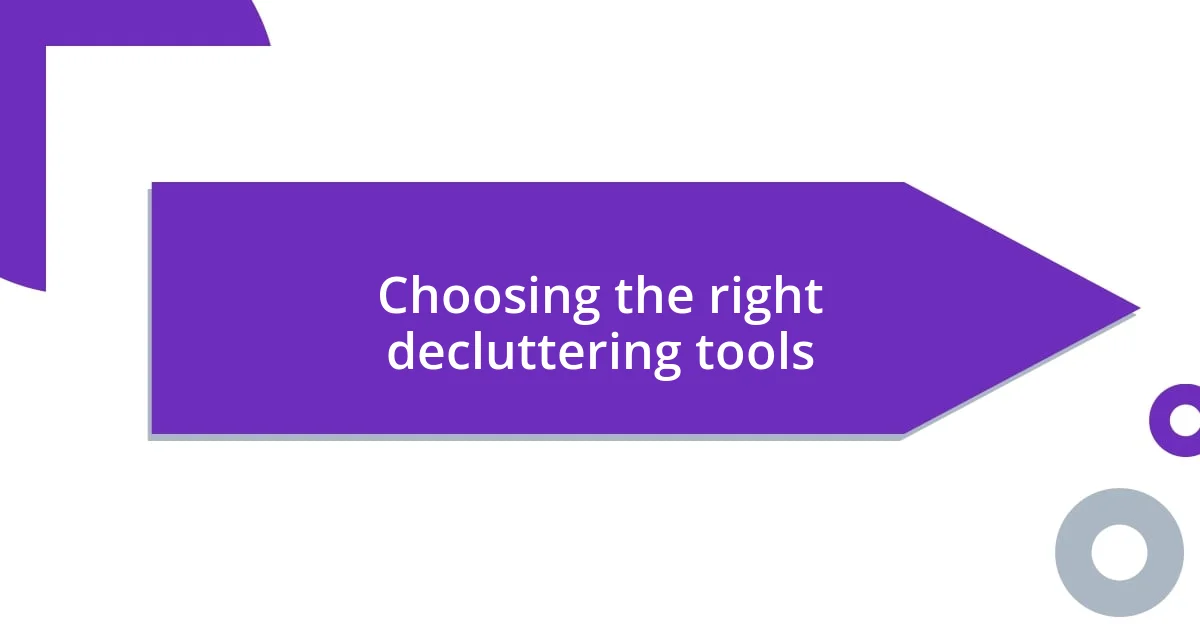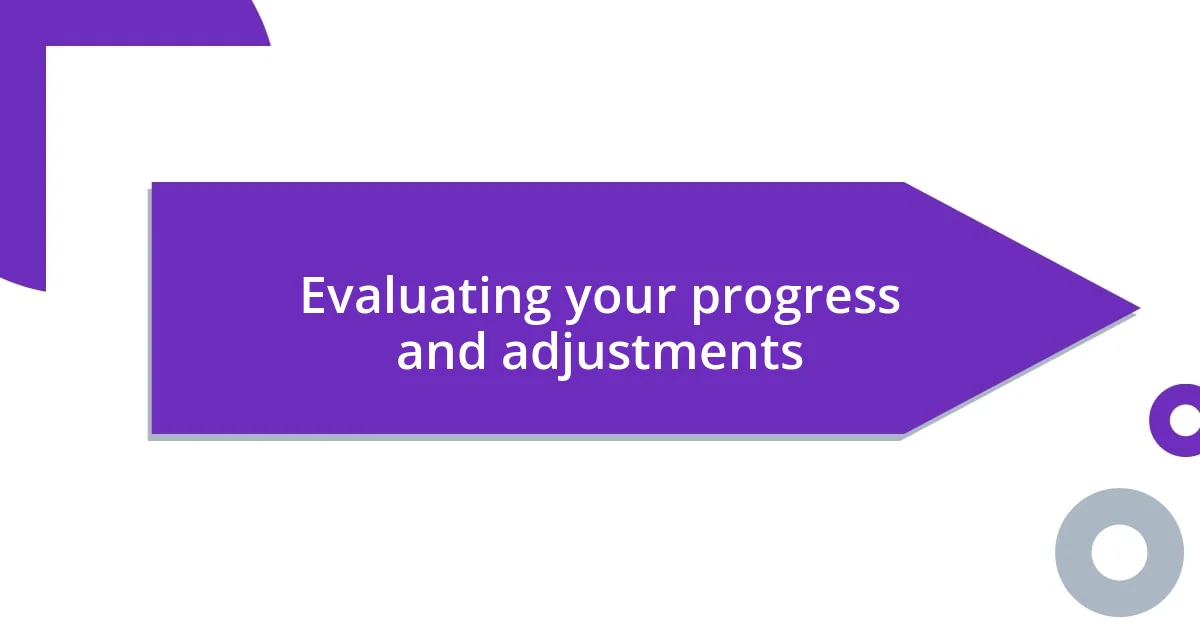Key takeaways:
- Digital clutter affects both productivity and mental well-being, emphasizing the importance of organizing emails, files, and social media habits.
- Setting specific goals and a decluttering schedule can transform overwhelming tasks into manageable steps, leading to emotional relief and clarity.
- Ongoing evaluation and adjustments of your digital space ensure it remains organized and aligned with your current needs, fostering a positive environment.

Understanding digital clutter
Digital clutter often creeps into our lives without us even noticing it. I remember the moment I opened my laptop to find thousands of unopened emails, countless browser tabs, and a chaotic desktop filled with old files. It hit me—this mess was not just a digital nuisance; it had started affecting my mental space as well.
When I finally took a moment to assess what I had, the sheer volume of unused apps and outdated documents felt overwhelming. It’s fascinating how quickly we accumulate this clutter, often without realizing that each file, photo, or app serves as a little reminder of tasks and memories we never followed through on. Have you ever felt that sense of dread looking at a messy inbox? I certainly have, and it made me realize that digital clutter isn’t just about the files; it’s about the emotional weight they carry.
Understanding digital clutter means recognizing that it impacts our productivity and mental well-being. I’ve found that every unnecessary email or app adds a layer of stress, almost like carrying around extra baggage. So, what if we considered this clutter a reflection of our digital lives? By tackling it, I believe we can reclaim not only our devices but also our peace of mind.

Identifying your digital clutter sources
When I began my journey of identifying the sources of my digital clutter, I quickly realized that social media was one of the main culprits. I found myself mindlessly scrolling through feeds filled with irrelevant posts and notifications that distracted me from more meaningful tasks. Reflecting on this, I asked myself if the joy those platforms once brought was worth the mental chaos they instigated. What do you think? Is it time to evaluate your social media habits?
Another surprising source of digital clutter for me was my email subscriptions. I had signed up for countless newsletters, thinking they would provide valuable insights that never came. Instead, they jammed my inbox, distracting me from important emails. It was an enlightening experience to see just how much I had accumulated without even realizing it. I began unsubscribing from everything that didn’t serve my interests, and the relief was immediate.
Lastly, I discovered that my file organization—or lack thereof—contributed heavily to my digital mess. My documents folder was a chaotic mix of work files, personal notes, and random downloads. I felt like I was searching for a needle in a haystack every time I needed something important. Taking the time to categorize my files gave me a sense of control and clarity, and I realized how deeply organization impacts my productivity and peace of mind.
| Source of Clutter | Impact |
|---|---|
| Social Media | Mental distraction from meaningful tasks |
| Email Subscriptions | Overwhelming inbox clutter and distractions |
| File Organization | Difficulties in finding important documents |

Setting digital decluttering goals
Setting goals for digital decluttering can feel daunting, but I’ve found that starting small makes the process more manageable and rewarding. Initially, I focused on one area at a time—like my email inbox—with a specific target: to reduce my unread emails to zero. This clear benchmark gave me immediate motivation and satisfaction as I watched that number drop. If you’re feeling overwhelmed, consider setting your own achievable targets, as it transforms a huge task into smaller, more digestible pieces.
Here are some practical digital decluttering goals to consider:
- Limit unread emails: Aim for a target number, such as under 50 unread messages.
- Organize files: Create clear folders and subfolders for different categories (e.g., work, personal, bills).
- Evaluate apps: Uninstall any apps that you haven’t used in the last month.
- Schedule social media breaks: Decide on specific times when you’ll check social media notifications.
- Unsubscribe from newsletters: Set a goal of unsubscribing from at least five irrelevant newsletters per week.
As I tackled my goals, I realized the emotional liberation that came with every small victory. Each step I took not only decluttered my digital life, but also cleared my mind, creating space for new ideas and inspiration.

Choosing the right decluttering tools
Choosing the right decluttering tools can make a world of difference in simplifying the process. When I first started, I experimented with various apps designed for digital organization, but not all of them spoke to my needs. After some trial and error, I found tools like Evernote for note-taking and Trello for task management, which helped turn my chaotic information into structured, actionable lists. Have you found your go-to tool yet?
In addition to apps, I discovered that a good old-fashioned spreadsheet could be incredibly effective for tracking my progress. Creating a simple chart allowed me to visualize my digital clutter and see how far I’d come. As I filled those cells, I felt a sense of accomplishment building. It’s a tangible way to keep myself accountable. Have you ever considered using spreadsheets for your own decluttering journey?
Lastly, don’t underestimate the power of browser extensions. These little tools can help you manage your time online and reduce distractions. For instance, I installed the StayFocusd extension, which limited my social media usage during work hours. This small adjustment transformed how I approached my day—less mindless scrolling meant more focused productivity. What adjustments can you make to regain your time and energy?

Creating a digital decluttering schedule
Creating a digital decluttering schedule can greatly enhance your motivation and effectiveness. I like to break my decluttering process down into manageable chunks, setting specific time slots for each task. For example, I dedicated Sunday afternoons to cleaning out my email, which not only became a routine but also something I genuinely looked forward to as a way to ease into the week ahead.
When I first started, I underestimated the importance of consistency. I realized that lengthening my decluttering sessions without a clear plan often led to burnout. So, I decided to commit just 20 minutes a day to one specific area—whether it was organizing files or evaluating my apps. It was amazing how much I could accomplish in that short time, and suddenly, the overwhelming task seemed like just a series of mini projects.
Ultimately, a well-structured schedule helped me foster a sense of control over my digital space. Have you ever felt that rush of satisfaction when completing a task? For me, each completed session turned into a mini celebration, reinforcing my commitment to a clutter-free digital life. Setting aside time regularly not only kept the momentum going but also slowly transformed my environment into one that inspired clarity instead of chaos. What could your schedule look like if you embraced the idea of small, consistent steps?

Maintaining a clutter-free digital space
Maintaining a clutter-free digital space requires ongoing diligence, something I learned through experience. After my initial decluttering spree, I noticed that my digital file system could quickly spiral out of control again. To combat this, I set aside a few minutes each week to review my folders, deleting files that no longer served a purpose. Hasn’t it ever felt liberating to let go of what you don’t need?
One method that has worked wonders for me is the “one-in, one-out” rule. Whenever I download a new app or save a new document, I make it a point to remove something else. This habit not only prevents stagnation but also keeps my digital life tidy. It’s a simple approach, but the discipline it instills is game-changing. Have you tried incorporating this rule into your routine?
I’ve also found that periodically refreshing my desktop environment is essential to my mental clarity. I like to switch things up by organizing my desktop icons into folders based on projects and priorities. Every time I do that, it feels like I’m rejuvenating my creativity and focus. Have you ever noticed how a clean workspace can improve your mindset? For me, that small act of tidying up fosters an inviting atmosphere that sparks inspiration and drives productivity.

Evaluating your progress and adjustments
As I progressed on my digital decluttering journey, I quickly learned that evaluating my progress was crucial to staying on track. I remember reviewing my email folders one day and being surprised at how many unread messages I had initially overlooked. Taking a step back to assess my progress not only felt fulfilling but also highlighted the areas where I could improve, like developing better tagging habits for my emails.
Making adjustments based on these evaluations came naturally after a while. For instance, I realized that the way I was organizing my files wasn’t as intuitive as I thought. So, I took the time to reorganize my file structure, creating a more logical flow that actually made finding things easier. Have you ever felt the excitement of discovering a more efficient way to do something you thought was already working? That moment when everything clicks can be incredibly motivating, fueling my desire to maintain this newfound system.
Remember that the process is dynamic, and flexibility is key. I found that every few months, I needed to reevaluate not just what I had and where everything was, but also how I was feeling about my digital space. One time, I noticed that I was feeling increasingly drained by the sheer number of apps cluttering my phone. The decision to remove the unnecessary ones was tough, but once I did it, the weight lifted, and I felt empowered. Have you considered how much your digital environment affects your mood? Taking stock and making intentional adjustments allow me to continually create a space that reflects my current needs and values.













